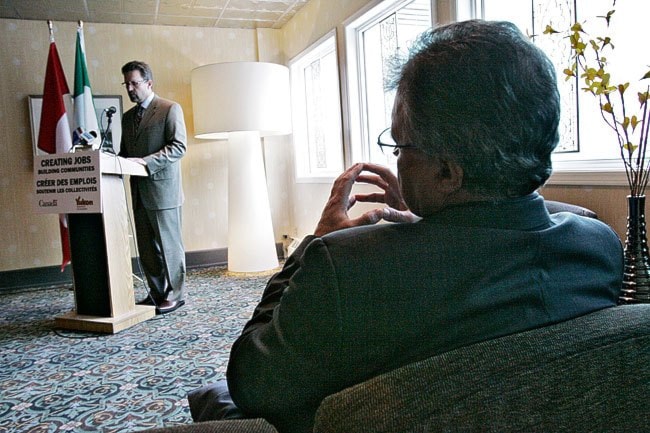Indian and Northern Affairs Minister Chuck Strahl dismissed a report by the right-wing Fraser Institute, which, using figures from Statistics Canada, found spinoff effects from the oft-touted Economic Action Plan were negligible in the last fiscal year.
“It’s simply not true,” said Strahl, who was in Whitehorse making several funding announcements Friday.
“It’s easy now when we’re looking at ongoing job growth, good growth in the economy, increased confidence, a bounced-back stock market, all those things, to say it was all in hand and you shouldn’t have done anything,” he said.
“Thanks, Fraser Institute, for coming out.”
The report, published last week, didn’t argue that the government shouldn’t have done anything.
It just says the stimulus didn’t cause any real economic growth.
By examining government consumption and investment at two critical junctures in the last year, and comparing them to the concurrent growth in the Canadian economy, the institute found those two indicators of state-sponsored stimulus were miniscule.
Of the 1.1 per cent growth of GDP from the second and third quarter of 2009, only 0.1 was due to government consumption and investment. Businesses provided 0.8 of the GDP growth.
Between the third and fourth quarters, GDP grew by one per cent. Government stimulus had no effect, the Fraser Institute found. Rather, net exports caused that growth.
The institute believes tax relief would have been more effective.
But Strahl had no time for financial analysis on Friday.
“Frankly, I think outfits like the Fraser Institute are a little cocky,” he said.
Strahl, after all, was in town to announce federal funding.
A high-tech mine simulator, a veternary clinic and a bevy of water treatment structures were just some of the goodies Strahl announced during a whirlwind announcment tour.
In the Yukon, Ottawa will spend $81 million on wells, solid-waste plants and roads, Strahl said in the lobby of the Westmark hotel. Premier Dennis Fentie and Community Services Minister Archie Lang stood by Strahl during the announcement.
The money is coming out of the Building Canada program. Both Ottawa and the Yukon put money in the fund, with the federal government picking up most of the bill.
Of the projects, 11 are allocated during the 2009-2010 year, totalling a $38.15 million investment, said a news release.
That doesn’t mean the projects — like water system upgrades in Faro, Watson Lake, Mayo and Haines Junction — haven’t already been built. The money Ottawa is sending to the projects has just only been allocated to the last fiscal year.
It’s the same thing for the money that Strahl announced for the 2010-2011 year. That cash is intended for 19 projects, totalling $43.65 million.
The only money mentioned by Strahl that will be spent in the coming fiscal year will be $3.3 million intended to plan for the previous years’ projects, said Cathrine Morginn, a communications coordinator with the Department of Community Services.
The projects will likely be built once the planning is done.
Ottawa’s share of the Building Canada funding is determined by the Base Funding Agreement. In the 2009-10 fiscal year, $26.1 million was handed to the Yukon. Next year, it will be $26.3 million.
Over the seven years of the program, $182.9 million will head to the territory.
The projects were plucked from the 2009-10 and the 2010-11 annual capital plans, submitted by the Yukon.
Moments after the announcement, Strahl walked into an economic development conference down the hall at the Westmark.
There, he announced $2.25 million for the Yukon Mining Training Association.
Most of that is going to a $1.5 million portable mine-equipment simulator. The simulator, built by South Africa-based Thoroughtec Simulation, is kept inside a transport container and can recreate underground and surface mining conditions, said Tracy Thomas, executive director of the mine training association.
The simulator is more than a joy-stick and a computer screen. It recreates all the controls of most heavy machinery, said Thomas. Thoroughtec also makes military simulators.
The remaining $750,000 Strahl announced for the association will go to purchasing and developping curriculum for potential mine workers.
A course in underground mining, created by the Saskatchewan Institute of Applied Science and Technology, will be bought with the money. And so will a course in heavy equipment, created by Camrose-based High Velocity Equipment Training.
A curriculum to train environmental managers is being designed in-house with the money, said Thomas.
All that money comes from the Community Adjustment Fund, money which is administered by the Canadian Northern Development Agency.
The money will put at least two people to work, said a news release.
And earlier on Friday, Strahl announced $1.929 million for the construction of an animal research and rehabilitation centre at the Yukon Wildlife Preserve.
The centre will allow preserve staff to better treat injured animals and nurse them back to health.
In 2009 and 2010, the preserve treated 17 injured or orphaned animals, of which four were mammals and 13 were birds.
A lynx that had been hit by a car and suffered a concussion was brought in, treated and re-released last year, said Krista Prochazka, executive director of the preserve.
A baby elk whose mother died was also treated and now lives on the preserve, she said.
The injured birds include two kestrels pushed out of their nest by competitive siblings. They were successfully raised on the preserve.
The new veterinary centre, to be built by Kobayashi + Zedda Architects, will provide 1.5 jobs once it’s built.
Contact James Munson at
jamesm@yukon-news.com.
